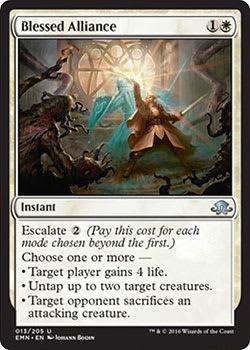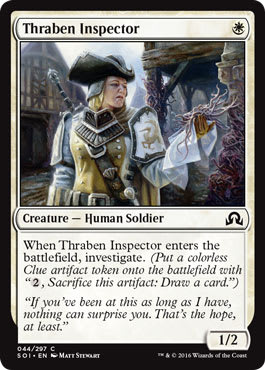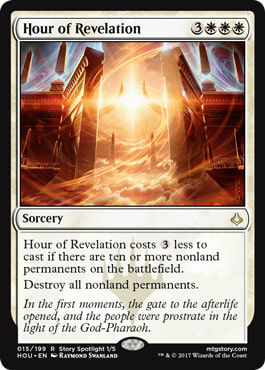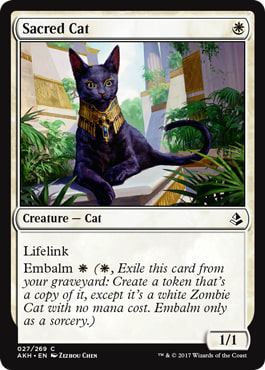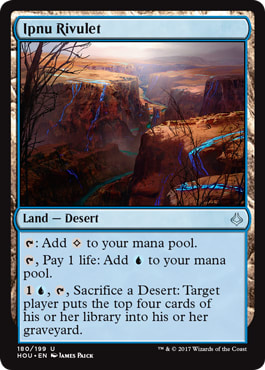My Ancestral Recall Podcast sidekick Roman Fusco made Top 8 of another Classic; again with another sweet, so-different, deck designed by the inimitable Dan Ward:
W/U Approach Control ? Hour of Devastation Standard | Dan Ward
- Instants (21)
- 2 Unsummon
- 3 Hieroglyphic Illumination
- 4 Blessed Alliance
- 4 Censor
- 4 Glimmer of Genius
- 4 Supreme Will
- Sorceries (7)
- 3 Approach of the Second Sun
- 4 Fumigate
- Enchantments (7)
- 3 Cast Out
- 4 Aether Meltdown
- Lands (25)
- 6 Plains
- 9 Island
- 2 Blighted Cataract
- 4 Irrigated Farmland
- 4 Prairie Stream
- Sideboard (15)
- 4 Authority of the Consuls
- 2 Hour of Revelation
- 2 Linvala, the Preserver
- 2 Negate
- 2 Regal Caracal
- 2 Torrential Gearhulk
- 1 Descend upon the Sinful
He was kind enough to loan me his victorious (okay, semi-victorious) physical cards, on the way to my third straight FNM victory, with a third, different, deck.
While I super love playing the ![]()
![]() Approach deck, and think it is perhaps the most elegant deck to play in the current Standard, I noticed over the course of my FNM run a number of disturbing non-bos.
Approach deck, and think it is perhaps the most elegant deck to play in the current Standard, I noticed over the course of my FNM run a number of disturbing non-bos.
Some of this sheeeeet just doesn’t go with some of the other sheeeeet.
Non-Bo #1: Aether Meldown + Blessed Alliance
Roman actually “won” the Classic Swiss, but lost in the quarterfinals to Emma Handy’s Zombies, despite beating multiple swarms of rotting brain-munchers earlier in the day.
His major complaint?
Emma simply attacked correctly.
The weakest card in the starting sixty is Aether Meltdown. That card gains a little outsized value in some decks because of the Energy line, but I don’t personally even keep track of my Energy playing this deck. While there are technically two Energy spells, there are no actual Energy sinks.
Aether Meltdown is simply fast (so can be a decent stopgap for hasty swingers like Earthshaker Khenra or Ahn-Crop Crasher), and actually provides 80% coverage to an indestructible Red God. The ![]()
![]() deck doesn’t care overmuch about utility creatures; so forcing the opponent to commit more and more to the battlefield into a Fumigate is basically even.
deck doesn’t care overmuch about utility creatures; so forcing the opponent to commit more and more to the battlefield into a Fumigate is basically even.
On balance, Blessed Alliance is the best-worst card in the deck. It’s the best when you Fumigate the face, leaving only the usually indomitable Hazoret the Fervent. Hazoret in the Red Zone and Blessed Alliance are basically peanut butter and chocolate; gaining four extra is nice (but you probably shouldn’t pay five life for the privilege if you know what I mean).
It is worst when you draw both, but in particular when you play Aether Meltdown first. This sequence is fairly intuitive (especially if you are greedy) because you want to cast Blessed Alliance when you have 4+ mana, or save it for Hazoret post-Fumigate.
Some players will stop attacking with a creature wearing Aether Meltdown, basically ignoring it until it is time to bury all the creatures. The good ones don’t.
Why?
Because if you attack with a creature wearing Aether Meltdown in addition to other creatures, you can cover the Blessed Alliance by sacrificing the already-nullified threat.
That is awful (!!!) for the ![]()
![]() Approach player.
Approach player.
The Fix:
There is no easy fix, at least as long as you play both cards. The “simple solution” is to play Blessed Alliance first . . . But as we said, that limits your upside. It is also not a cure if you just draw Aether Meltdown and play it; and then draw Blessed Alliance afterward. There is no consistent way to plan for that.
One proposed change is to just not play Aether Meltdown (which is the weakest card in the deck). A reasonable option is Thraben Inspector. That card only costs 1 mana and is a pretty good speed bump against Mono-Red. It also draws a card and can annoy a mirror opponent at least a little bit. The problem is that while no one really wants to aim a Shock or Fatal Push at a Thraben Inspector, when the alternative is “g-d nothing” (there are literally no creature targets in the traditional main deck) that Shock or Fatal Push suddenly represents a ton of actual damage.
On the other hand, Thraben Inspector is a lot stronger in control matchups! Not strong enough to actually win or anything, but hassling life total at least a little bit + drawing a card is leagues better than Aether Meltdown, one-for-one.
Non-Bo #2: Cast Out / Authority of the Consuls + Hour of Revelation
In my first round of FNM last week I faced off against a ![]()
![]() Reanimator strategy that featured Gate to the Afterlife (so presumably God-Pharaoh's Gift) and The Scarab God.
Reanimator strategy that featured Gate to the Afterlife (so presumably God-Pharaoh's Gift) and The Scarab God.
Fumigate only goes so far against a deck that can re-use all its threats, but Fumigate bought me enough life, and therefore time, to land consecutive sorcery sevens and win Game 1.
I went to boards and chose both Authority of the Consuls and Hour of Revelation in addition to Descend Upon the Sinful and the Linvala twins; taking out one Approach of the Second Sun (leaving two) and some sundry one-for-one interaction.
My theory was that Authority of the Consuls would be great at countering the haste of God-Pharaoh's Gift, that Descend Upon the Sinful would be great at pre-empting reanimation (in addition to just being a fifth Fumigate) and that Hour of Revelation might be the best of them all: Sixth Fumigate and answer to the full machinery if it all got on the battlefield.
The counters in Roman’s deck aren’t super fast or reliable [as counters] so I assumed that the machinery would in fact get on the battlefield and that I’d have to find a way to win anyway. Cast Out stayed as one-of spot interaction versus specifically artifacts.
Game 2 was a trial. I was barely alive come mid-game, largely because I had gotten lucky with some Fumigates and Authority of the Consuls was narrowly keeping me alive against an active The Scarab God.
I drew Hour of Revelation and became very excited!
And then I deflated.
“If I cast this,” I quickly realized, “not only will I destroy my own Authority of the Consuls, but I’m just going to unlock the 5/5 under that Cast Out and die to it in two swings.”
Hour of Revelation stank up my hand for the rest of the game; which was thankfully short because I ripped Linvala, who triggered both sides (obviously). Linvala’s 5/5 body held off the measly 4/4s while the 3/3 body rained hell from high above the battlefield. The whole nasty business only took a couple of turns thanks to flying.
But I had just gotten lucky.
Hour of Revelation wasn’t good in that spot at all. As I rattled through potential matchups where I’d want Hour of Revelation . . . so So SO many also had me siding in all four copies of Authority of the Consuls! And I don’t know a single spot where I’d want to side away Cast Out.
Worse came Round Three . . .
I beat a Mardu Vehicles deck on a little luck and a lot of Fumigates.
Lan watched from behind and we discussed the Approach v. Mardu matchup at length. It’s extremely difficult. Basically, they have insane threats (two or even 3 power threats for 1 mana, resilience through sweepers via both Heart of Kiran and Planeswalkers, and even Black [or sometimes Blue] methods of interacting with Approach of the Second Sun itself).
Lan argued you had to have Hour of Revelation, and even suggested two copies in the sideboard!
Once again, I pointed to Authority of the Consuls. I felt like it saved my bacon that match. At least if I lived a turn via Fumigate, I could avoid an insta-crew [in addition to a small life buffer].
What’s a girl to do?
The Fix:
The two sideboard cards can’t really coexist long-term.
I am super in love-in love with Authority of the Consuls, but I worry that that is just an emotional reaction based on how badly it blunts Mono-Red [when you have a Crested Sunmare in play] [in a different deck].
You need speed bumps and you want life gain. Lan’s suggestion? Eight cats.
The deck already has Regal Caracal.
What about the full set of Regal Caracal and the full set of Sacred Cat? Sacred Cat is not nearly as embarrassing as it might seem initially. Not only does it have a great casting cost and similarly great embalm cost, if all you want to do is bridge time while you gather other resources, it does a wonderful job of slowing down Toolcraft Exemplar and an unbelievable job against Earthshaker Khenra or Dread Wanderer.
And late game? When you have big daddy five-cat online?
Sacred Cat don’t mess around.
Non-Bo #3: Fourteen versus Nine-point-five
When faced with another ![]()
![]() Control deck* (or combo deck) there are fourteen main deck cards that are generally thought to stink:
Control deck* (or combo deck) there are fourteen main deck cards that are generally thought to stink:
They have varying amounts of relevant text but Aether Meltdown is the worst.
The problem is that you have at max nine-point-five cards to side in.
You definitely want all of Linvala (2), Regal Caracal (4), Torrential Gearhulk (6), and the permission (9). The half-card is Descend Upon the Sinful.
Descend isn’t good by any means but it’s probably better than Fumigate. You are unlikely to ever get the opponent by sweep with either, but Descend’s possible upside of a 4/4 Angel is far superior to gaining one life point.
I ultimately don’t like Descend, not only because 6 mana for a 4/4 is kind of clunky . . . But because the deck is so thick with instants and sorceries you might never achieve Delirium. If it had some Evolving Wilds I might adjust my opinion, but Descend going 4/4 will only happen in a very very long game where you’re ok with blowing a land or discarding to hand size.
The Fix:
In practice, I ultimately sided out all the Aether Meltdowns, three Fumigates, and two Blessed Alliance against my ![]()
![]() combo-control opponent. The removal cards are all varying levels of bad. If you’re playing against
combo-control opponent. The removal cards are all varying levels of bad. If you’re playing against ![]()
![]() , say (or Esper, which might have Shambling Vent) Blessed Alliance is actually okay; you can snipe a land and you might even want four life. If the opponent sides in Regal Caracal you actually want to go kind of wide (Fumigate) because Blessed Alliance is horrible if they can simply sandbag a Cat token. On the other hand, Blessed Alliance is a better answer by far to Torrential Gearhulk than Fumigate is.
, say (or Esper, which might have Shambling Vent) Blessed Alliance is actually okay; you can snipe a land and you might even want four life. If the opponent sides in Regal Caracal you actually want to go kind of wide (Fumigate) because Blessed Alliance is horrible if they can simply sandbag a Cat token. On the other hand, Blessed Alliance is a better answer by far to Torrential Gearhulk than Fumigate is.
But they’re all bad.
Except Unsummon.
Unsummon is the second-weakest card, generally speaking, in the main deck. It might be the #1 coolest card, but that is a different thing entirely. It can make the opponent pick up Hazoret; or it can blank Hazoret by making them pick up somebody else for the turn, going to too many cards in hand. It’s great against Earthshaker Khenra tokens, and buys you time when you’re ahead on card advantage but you need life points.
When sideboarding yourself, Unsummon is great because all your cards — in particular Torrential Gearhulk — have 187 effects. I won a match by landing Torrential Gearhulk and playing my seventh land; then responding to a big turn by Unsummoning the Gearhulk and re-playing it to flash back a Supreme Will I had used earlier in the game.
Cool, right?
Off-brand, but cool.
The Fix:
The “14 v. 9.5” issue is actually more a symptom than the illness itself.
The main deck construction of this deck is very odd when talking about dealing with, say, itself. I’m not even sure how to fix the problem because part of me wants to hit all my land drops (which might involve using Supreme Will as an Impulse) and part of me wants to cover the opponent’s [second] Approach of the Second Sun . . . with precious little reliable permission.
To put it all together, I’d advocate for one change and then just talk about another.
First off, I’d definitely change the two copies of Blighted Cataract into Ipnu Rivulet. Roman suggested this to me before FNM but I told him I’d rather just play his Classic deck. A two-for-two swap there has a minimum negative impact because you sacrifice Blighted Cataract to draw cards but rarely. Both lands enter the battlefield untapped and tap for colorless. Ipnu Rivulet has the upside of potentially tapping for Blue. That means you can keep more hands! For example you might normally mulligan a hand on the play with Blighted Cataract, Plains, and Censor; but with Ipnu Rivulet, you would be more likely to keep it.
More importantly, Ipnu Rivulet actually does something you want, especially in mirrors or against other control decks. Winning against another Approach of the Second Sun deck is really weird. Adding Ipnu Rivulet gives you the additional capability to “aim” for an opposing physical Approach of the Second Sun because you know where it is after it resolves the first time.
That swap is very near turning a Gray Ogre into a Suq'Ata Lancer if you grok; but it’s possible you should change out two Islands for all four, also (haven’t tested that change, sorry).
The other update I’d think long and hard about is Sphinx of the Final Word. Simply, it makes Approach of the Second Sun uncounterable. So, assuming the opponent has sided out Fumigate, it pretty much isn’t going anywhere (you might want to think twice about attacking due to Blessed Alliance possibilities, of course); but you have raw inevitability if you can untap with it in play.
Whether you actually adopt any of these changes or not, the important thing to understand is that ![]()
![]() Approach of the Second Sun is chock full of weird non-bos. That doesn’t stop it from being one hell of a deck; it is just important that you know about them so that you can maximize your ability to play to the deck’s potential. It is all over MTGO, and will likely be a force at the RPTQs and other key Standard tournaments this weekend.
Approach of the Second Sun is chock full of weird non-bos. That doesn’t stop it from being one hell of a deck; it is just important that you know about them so that you can maximize your ability to play to the deck’s potential. It is all over MTGO, and will likely be a force at the RPTQs and other key Standard tournaments this weekend.
LOVE
MIKE
* Note: I’d say something completely different about a ![]()
![]() Control deck that seeks to win with Wandering Fumarole and Torrential Gearhulk, but that’s another topic.
Control deck that seeks to win with Wandering Fumarole and Torrential Gearhulk, but that’s another topic.














